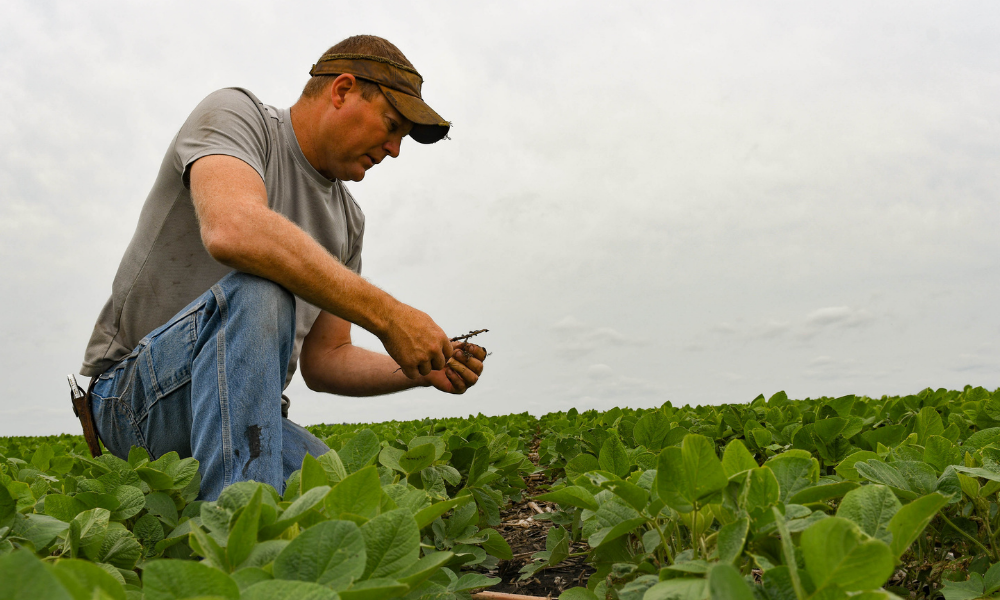
Brock Hansen scouts soybeans in his field near Baxter. Farmers continue to look for ways to raise higher-yielding soybeans. (Photo: Joseph L. Murphy/Iowa Soybean Association)
9 steps to higher soybean yields
March 15, 2021
With current rises in soybean prices, the Iowa Soybean Association (ISA) is receiving many inquires on how to raise higher yielding soybeans. The following are nine low-cost, high-return options for raising high yield soybeans.
1. Spend time on variety selection.
Selecting and placing the right varieties for your acres is the most important thing a farmer can do to optimize yield. Unfortunately, this is also one of the most difficult steps as there is no single source of credible information. It is very important to select several varieties with varying maturities, agronomic characteristics, disease and insect resistance, along with herbicide tolerance traits. We recommend consulting three to five seed companies. Spend time scouring seed catalogues and talking with sales representatives and agronomists to discuss the characteristics and traits you seek. Select varieties and maturity groups with the yield potential and genetics and traits packages most appropriate for your situation and practices.
2. Know your fields and consider your cropping system.
Scout fields and sample soils frequently to know your status and longer-term patterns and trends for yields, fertility, soil health, drainage and water management, and disease (including SCN), insect and weed pressures. Several companies now offer field satellite images. Consider past and current crop production and management practices and seek new ideas and technologies for continuous improvement. By knowing your land and how you farm it, you can better evaluate new approaches, opportunities for improvement and specific short-term needs that will ensure maximum profitability. The ISA Research Center for Farming Innovation (RCFI) has holistic programming to assist with agronomic, conservation and decision tools.
3. Maintain your fertility foundation.
With lower commodity prices in past years, some farmers have neglected their pH levels and P and K applications. Soybeans respond to lime when pH is below 6 and they consume a lot of potassium. We recommend grid sampling on 1.25-to-2.5-acre grids to determine optimum variable rate applications of lime, phosphorous and potassium.
4. Plant early and consider prescription planting and variable variety placement.
RCFI has conducted planting date trials at 20 locations over the past two years. Consistently, the data and university studies show that planting in late April or early May gives a 5-to 10-bushel advantage over planting later in May or in June. Many cases have also shown a yield advantage for planting a slightly later maturing variety in the early planting window.
5. Use of seed treatments and inoculants.
When planting soybeans in the normal corn planting window, seed treatments for soybeans can have a large return on investment. If Sudden Death Syndrome (SDS) is a problem, select seed treatments that have good activity on SDS when planting early. Other fungicide treatments are especially important when planting early. RCFI results with nitrogen-fixing bacteria inoculants have been mixed. In some years, there has been a significant yield response, while in 2020, the yield response was almost zero. We still believe that high-quality inoculants and some of the newer bacteria being introduced could lead to a yield advantage, but we lack proof. Inoculants in our estimation are a better practice than foliar nutrient feeding.
6. Use a preemergence herbicide.
Effective weed management requires you to know your weed pressures and then develop an integrated management strategy. With growing herbicide resistance in weeds, it is very important to apply multiple sources of active ingredients to protect yield. Preemergence herbicides are especially important as some of the sources of activity are not available for postemergence options.
7. Manage residue in no-till soybeans.
In some no-till fields, corn residue can hinder even stand establishment and leave gaps in the field. This is most often the case when high-speed drills are used where the implement has no way to move residue from the seed slot. Because seed placement is so important for stand establishment and plant growth and development, managing residue is becoming one of the biggest yield limitations in soybean production. Solutions include planting no-till fields with a planter equipped with residue managers and optimizing down-force pressure to achieve proper seeding depth. Great soybean stands begin at corn harvest. Making sure your harvester is processing residue well is very important for the following years soybean crop. In some cases, it may be profitable to invest in newer stalk roll designs that better shatter and size the residue.
8. Manage white mold.
In some areas and during some years, Sclerotinia stem rot or white mold is a devasting disease in high-yielding soybean fields. Always have a plan to manage this disease. Cover crops and application of lactofen (Cobra) herbicide have shown suppressive effects on white mold and some of the newer fungicides are showing greater activity against white mold. In our on-farm research experience, we have never seen a positive return on investment for two-pass fungicide applications in fields with white mold.
9. Don’t overlook harvest loss.
Soybean yields can be dramatically reduced by harvest losses from shattering and lodging. ISA has some farmer members who have found that harvesting soybeans at high moistures (above 17%) and drying them is more profitable than letting the soybeans field-dry and incur shattering losses. We do not know that this practice works for all farmers, but we do know that beginning soybean harvest around 14-15% moisture is a good practice to reduce harvest losses.
This story was originally published in the March 2021 issue of the Iowa Soybean Review.
Back